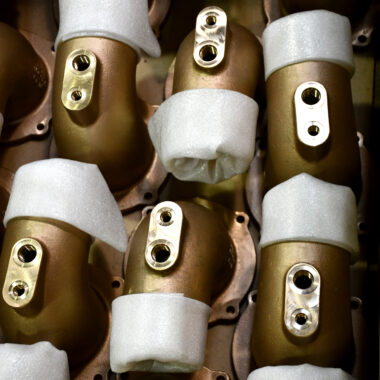Unraveling About Aluminum Casting: From Essentials to Expertise
Unraveling About Aluminum Casting: From Essentials to Expertise
Blog Article
Crafting Perfection: Exactly How to Accomplish High-Quality Light Weight Aluminum Castings Every Single Time
In the realm of light weight aluminum spreading, the quest of excellence is a constant journey that needs a precise strategy and a keen understanding of the intricacies entailed. Accomplishing regular high-quality light weight aluminum castings demands a thorough grasp of the procedures, from picking the suitable alloy to implementing precise mold designs and carefully controlling casting parameters.
Comprehending Aluminum Spreading Procedures
Light weight aluminum casting procedures, crucial in the manufacturing market, include the detailed improvement of molten aluminum into solid kinds via a collection of carefully controlled steps. Recognizing these procedures is paramount to accomplishing high-quality light weight aluminum spreadings constantly - about aluminum casting. The main approaches made use of in aluminum casting are pass away casting, sand casting, and investment spreading

Each of these procedures has its advantages and is picked based upon factors like complexity, quantity, and wanted coating of the light weight aluminum casting. about aluminum casting. Comprehending the complexities of these techniques is crucial for producers intending to generate top notch light weight aluminum castings constantly
Picking the Right Light Weight Aluminum Alloy
Picking the appropriate light weight aluminum alloy is an important decision in the manufacturing of top quality aluminum spreadings. The selection of alloy significantly influences the residential or commercial properties and attributes of the end product. Different aluminum alloys use differing levels of strength, deterioration resistance, machinability, and thermal conductivity. When selecting an aluminum alloy for casting, it is necessary to consider the specific demands of the application to make certain ideal efficiency.
One of the most generally used aluminum alloys for casting is A356 - about aluminum casting. For applications needing high strength, 7075 light weight aluminum alloy is a preferred selection due to its remarkable strength-to-weight ratio.
Along with mechanical homes, factors to consider such as expense, accessibility, and post-casting processes need to likewise affect the choice of the best aluminum alloy. By very carefully assessing these variables, makers can make sure the production of top notch light weight aluminum spreadings that fulfill the wanted specifications.
Executing Correct Mold And Mildew Style
Establishing an effective mold and mildew style is vital for making certain the effective manufacturing of high-grade light weight aluminum spreadings. Appropriate mold and mildew style plays a significant role in achieving the desired features of the last product. To carry out a successful mold and mildew design, variables such as product flow, cooling prices, and component geometry should be carefully thought about.
One trick element of mold design is guaranteeing correct dental filling and solidification of the light weight aluminum within the mold dental caries. This includes creating runner and gating systems that promote smooth metal flow and stop problems such as air entrapment or incomplete filling. In addition, integrating air conditioning networks right into the mold design helps manage solidification rates and lower the threat of porosity or contraction flaws.

Controlling Spreading Parameters

Making Certain Post-Casting Top Quality Checks
To maintain the high quality of light weight aluminum spreadings, comprehensive post-casting quality checks are vital. After the spreading process is finished, it is important to ensure that the last products fulfill the wanted specifications and criteria.
Dimensional precision is one more crucial element that must be confirmed during post-casting top quality checks. Measurements of key measurements and resistances should be taken to verify that the spreadings adapt to the called for specs. Additionally, mechanical properties such as solidity, tensile stamina, and influence resistance might require to be evaluated via product screening to make sure that the spreadings possess the required strength and sturdiness for their desired application.
Final Thought
In verdict, accomplishing high-grade aluminum spreadings needs a thorough understanding of the casting procedures, selecting the ideal alloy, developing molds efficiently, controlling spreading criteria meticulously, and carrying out post-casting quality checks diligently. By following these click to investigate actions, manufacturers can constantly create light weight aluminum spreadings that fulfill the highest possible standards of quality and efficiency.
Achieving constant top quality aluminum spreadings demands a detailed grasp of the processes, from picking the proper alloy to executing precise mold and mildew designs and meticulously controlling spreading parameters. The key techniques made use of in aluminum casting are die casting, sand spreading, and investment spreading.
Financial investment spreading, also recognized as precision spreading, involves developing wax patterns that are coated in ceramic to develop mold and mildews.Selecting the ideal aluminum alloy is an essential choice in moved here the manufacturing of top notch light weight aluminum castings.Guaranteeing precise control over spreading parameters is crucial for preserving uniformity and high quality in light weight aluminum spreading manufacturing.
Report this page